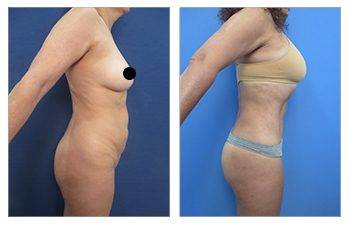


51-year-old female patient after her advanced liposuction revision procedure
Advanced Liposuction Revision
Advanced liposuction revision requires your surgeon to overcome three obstacles. These obstacles include eliminating any residual fat, removing all soft tissue scar tissues, and reducing overlying skin laxity. This is because these three factors are responsible for 99% of botched liposuction outcomes. Advanced liposuction revision surgeons must overcome these three obstacles to achieve exceptional results or what we call “SAVES” in the liposuction arena.
Eliminate all residual fat
Elimination of residual fat should be the goal of liposuction revision cases. It begins with an appreciation that fat is located in multiple layers. For most areas, the fat is located in the superficial and deep layers. These fat layers are separated by a fascial lining called the Scarpa. In the mid-waist and or flank region, the fat is located in three separate layers that include the superficial, deep, and middle layers. Uneven removal of these layers results in unevenness that is characterized by poor liposuction results. When uneven removal of the superficial layer is attempted, then botched liposuction results become apparent.
Removing soft tissue scars
You might be wondering what are soft tissue scars and why they are even a concern. Soft tissue scars result whenever soft tissues are exposed to mechanical stimulation such as liposuction. This is an inevitable consequence of liposuction and what makes revision liposuction so technical. Removal of scar tissue during liposuction surgery is what makes liposuction revision surgery so challenging. The use of ultrasound energy is critical to the removal of scar tissue. Traditional liposuction is unable to remove the scar tissue. When planning the advanced liposuction revision, it is important to allocate 1.5x the operative hours required to complete eliminating the residual fat strictly based on the fact there will be scar tissue. The scar tissue can be moderately difficult to remove or extremely difficult, which we refer to as concrete!
Reducing skin laxity
As a training center for surgeons interested in achieving high definition liposuction results, we are routinely sent liposuction revision cases to evaluate. It has become a realization that 9 out of 10 botched liposuction cases result from the retention of redundant skin. When the fat or pulp is removed without attention to the overlying skin or shell, then contour irregularities will occur. Skin laxity will result in waviness of the skin when minimal, and result in rolls of skin when moderate. If skin laxity is left unattended coupled with superficial liposuction, the appearance of cellulite will be apparent.
Elimination of skin laxity requires assessment of the degree of laxity and redundancy. For minimal skin laxity, Renuvion J plasma technology can be utilized to reduce laxity. For moderate to extensive skin laxity, excisional surgery may be required. This means utilizing strategic tucking procedures so that skin laxity if eliminated while keeping excision lines hidden. Examples of tucking procedures include a pubic skin resection, mini tummy tuck, modified abdominal skin resection on the front, and a lateral thigh and buttock tuck or upper body lift on the back.
Advanced Liposuction Revision Preparation
Preparing for liposuction revision surgery is critical to success. First, you must recognize that you will need ultrasound energy. This means you will have to make arrangements to have a VASER machine available. The ultrasound is needed for two reasons. The first reason is that VASER technology is required to eliminate fat comprehensively, especially that which is superficial. The second reason is that ultrasound energy is required to remove the scar tissue. The advanced liposuction revision cannot be achieved if both residual fat and all scar tissue are not removed. The second precaution is ensuring a high blood count. This is because the removal of scar tissue will undoubtedly result in more blood loss than a primary liposuction case. Patients should be ideally seen one month before surgery so that blood counts can be elevated when necessary. For minimal blood elevation patients are placed on iron supplementation by mouth taken daily. For moderate blood elevation, patients may be prescribed iron infusion.
Final Touches Of The Advanced Liposuction Revision
Sometimes the divots created from botched liposuction can be so dramatic and extensive that a combination of fat removal and actual fat transfer back may be required to correct deeper divots. In the abdomen, the divots created can be so extensive that they are termed the checkerboard abdomen, analogous to a checkerboard. Fat that is harvested from liposuction material can be added back. It is always prudent to use fat from areas not previously liposuctioned first to avoid replacement of fat cells that may have been previously injured. In this scenario, the liposuction and fat transfer are treated almost like a puzzle.
Advanced Liposuction Revision Conclusion
In summary, the advanced liposuction revision requires attention to the removal of residual fat, reduction of soft tissue scarring, and elimination of skin redundancy. Advanced liposuction surgery is much more technical and challenging than primary liposuction cases. Advanced liposuction revision requires advanced tools and expertise that can be afforded only by high definition liposuction surgeons.
